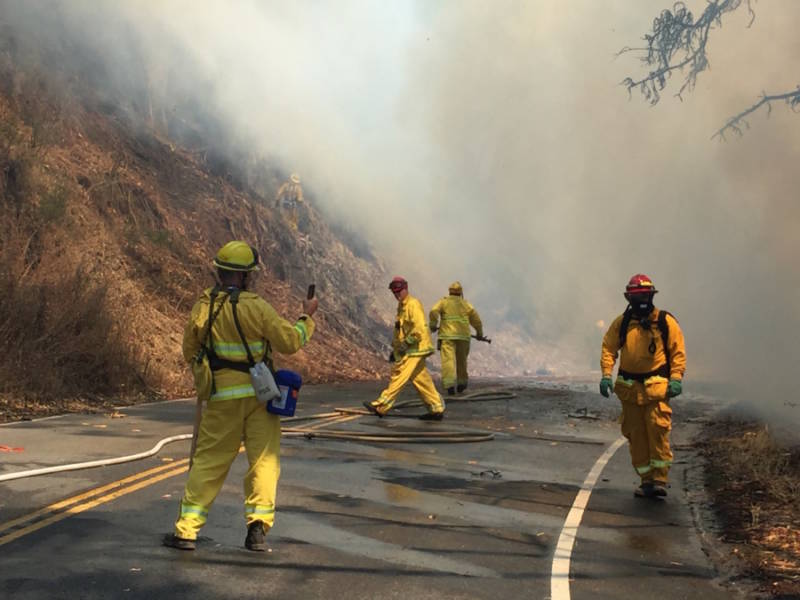After years of studies on the hills’ wildfire danger, the issues the city faces aren’t just known, they’re blatantly apparent. The area’s vegetation is like kindling when dried out and there’s lots of it. It needs to be cleared completely, but Brannigan says there hasn’t been enough funding for upkeep.
Compounding the danger in the hills are its curvy, narrow roads. They’re difficult to navigate, especially for today’s emergency vehicles. Also, on many sections of road, a parked vehicle jutting out into the road could prevent an ambulance from reaching its destination.
”Our emergency vehicles have difficulty accessing areas on a daily basis,” said Brannigan.
Along with the studies came plans to address the issues in the hills; some are already in place. This fall the city starts its Safe Passages Program, which creates new fire lanes on blocks identified as being problematic for emergency vehicles. The program will prohibit cars from parking there, ensuring there’s enough space for an ambulance or fire truck to pass through.
But Wengraf expects resistance to the expansion of no parking zones in the area. Despite the program proceeding slowly on just three streets (Alvarado, Bridge, and Vicente roads) and assurances that the program would maintain “some parking for the neighborhoods,” residents are already warning Wengraf that they plan to fight.
“One woman on Tamalpais told me she’d lay down in the street and block our trucks,” said Wengraf. “Some people think they own the street in front of their houses.”
Another battle is brewing over the plans to clear vegetation. Last month, the Claremont Canyon Conservancy published a wildfire fuel management plan for the University of California, Berkeley. The school received funding to make its campus and the surrounding area safe in the event there’s a wildfire so the conservancy commissioned a plan from Joe McBride, a professor emeritus of landscape architecture and environmental planning. McBride’s been studying the fuel management in the Berkeley Hills since the early ‘70s and has written four reports on the subject.
“Fuel management is a high priority for the area,” said McBride. “Past fires like the 1923 Berkeley Fire started in wildland vegetation and burned into the city.”
The first of McBride’s recommendations in his new plan is to replace the area’s eucalyptus trees and conifers with native vegetation and grass. McBride says trees release more energy during fires than grasses and tree fires are harder for firefighters to control — a claim Brannigan supports. The trees can also fall on roads and block evacuation routes.
“During the Oakland Hills fire in 1991, people died because one-way roads were blocked by trees,” said McBride.
But this plan also reignites the “Great Eucalyptus Debate,” a battle that’s been going on for over a decade between the Claremont Canyon Conservancy and Hills Conservation Network, a collection of local residents who want to keep the trees. Network representative Dan Grassetti said McBride’s new proposal offers “no wildfire risk mitigation benefit” and “is yet another attempt by a small group of native plant fanatics to attempt to influence the University to do their bidding.” Grassetti said the network would be willing to fight this new plan in court.
Grassetti, the president and CEO of the tech company Arboreal Systems, defers to FEMA officials on fuel management. They agree that the tree canopy is good for the area, providing shade and other benefits.
“We’re in better shape than Paradise because we have these forests. It’s wetter. The tall trees catch the fog and they drip water on the floor. That’s inherently safer than not having the overstory,” said Grassetti. “But if CCC gets its way, it will be more like Paradise.”
Brannigan also agrees with the need to keep a tree canopy. His concern is ladder fuels, which are debris on the ground that could send fires up into the trees. He advocates for funding more inspections and maintenance.
“People talk about species but we’re looking at our fire code and that’s about maintaining them,” said Brannigan. “Good maintenance of existing trees will go a long way to prevent the spread of a wildfire.”
One thing that everyone who spoke to Berkeleyside agrees on is that responsibility ultimately falls on the shoulders of residents. While these issues are hashed out, Wengraf, Brannigan and others feel the best plan for residents to stay safe in a wildfire is to be proactive and stay out of the area when fire conditions are at their worst. Residents shouldn’t wait for evacuation orders to leave because by then, it could be too late.
“The idea that the fire department is going to help you during a wildfire is a myth,” said Wengraf.

